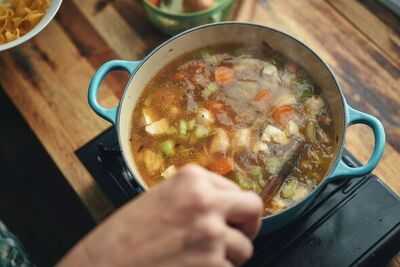
From leek and potato in winter to tomato and basil in summer, soup is a British staple precisely because it's simple, frugal and comforting. Yet the line between a soup you want to eat every day and one you never want again is very fine. Too much liquid and you're left with a weak, watery bowl; too little and the texture turns stodgy. I asked four chefs how they solve that balancing act fast, and they converged on one humble fix you likely already have in the cupboard.
The through-line is starch, used smartly and sparingly. Each expert favours a single ingredient that builds body without dominating flavour, then layers in technique to avoid lumps, gluey textures or lost nuance. The goal is a texture that's velvety and spoon-coating without compromising the vegetables and stock. For Sean Dell, Executive Head Chef at Horwood House in Buckinghamshire, the solution is as old-school as it is reliable. "Whatever soup I'm making, I always add a couple of large peeled chopped potatoes, it is a natural thickener and gives the soup a lovely creamy texture."
Sean warns against adding flour directly to the pot because "it can become lumpy," and he's wary of using too much cornflour: "You can go from a thin soup to a very thick very quickly!"
John Burton-Race, head chef at The Nook On Five, backs the same principle with a more precise tool: potato starch.
He said: "Don't put flour in to thicken it. This will just lump up. Instead, dilute a teaspoon of potato starch with a little water and stir it directly into your soup."
He notes that it's excellent for broths and meat-based soups, while creamy soups may simply require more cream.
Onion soup thickens naturally with the more onions you use, and classics like pistou soup can be enriched with egg yolk and cream-but make sure to take it off the boil first, warned John.
It's not just hearty spuds that can fix liquid-heavy soup. Lily Keeling, senior recipe developer at Green Chef UK, points to another starch-forward path, in the form of beans and pulses.
"Adding beans or pulses to a soup acts as a natural thickener; crushing or blending them releases the starches, which thicken soups and sauces for a nice smooth consistency-it's also added fibre."
Lily doesn't shy away from using flour as a soup thickener, but says she always mixes flour or cornflour with water to create a slurry before adding it to the soup.
Timing is also important if you're considering trying to thicken the texture of your broth.
According to John, the golden window is usually when you're blending the soup; this is when you can tell if the liquid amount is too much.
That is why restraint is crucial when whipping up a homemade soup. Lily said, "You can always add, but you can't take away," so don't drown the pot early.
If it's still thin near the end, thicken it or "leave it to simmer and reduce... to deepen and develop the flavours."
For flavour, Vegan author, blogger and recipe creator Romina Callwitz leans on umami rather than dairy: "One ingredient I often add to soup to take it to the next level is a splash of miso paste.
"It instantly deepens the flavour and gives even simple vegetable soups a rich and savoury boost."
She's happy to use shop-bought stock in a pinch, but says homemade stock "really makes a difference and adds depth of flavour," and she personally avoids vegan cream and butter because they "mask the natural flavours of the vegetables."
You may also like

I asked 8 experts the best way to remove mould from walls - they all said the same thing

Pat Cummins Doubtful for First Ashes Test Due to Back Injury

School holiday on October 13: Check the states that have declared Diwali vacations

Rajasthan: CM Bhajanlal reviews preparations ahead of Amit Shah's visit for new criminal laws exhibition in Jaipur

Blinkit's Operational Chaos, 1mg's Full-Stack Sprint & More






